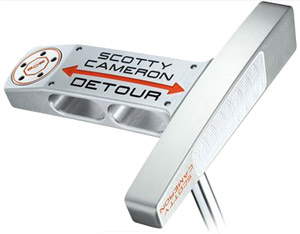 Scotty Cameron putters are synonymous with tradition, elegance, and simplicity. With the exception of the geeky (and I mean that in a good way) Futura, Cameron’s putters feature simple, austere designs, clean lines, and a classic look that begs the owner to use the putter as frequently as possible. Once on the course, Cameron’s putters are often used quite infrequently – they’re as good as any on the market at getting the ball in the hole, and many of the world’s top PGA Tour stars rely on Cameron putters to earn a living.
Scotty Cameron putters are synonymous with tradition, elegance, and simplicity. With the exception of the geeky (and I mean that in a good way) Futura, Cameron’s putters feature simple, austere designs, clean lines, and a classic look that begs the owner to use the putter as frequently as possible. Once on the course, Cameron’s putters are often used quite infrequently – they’re as good as any on the market at getting the ball in the hole, and many of the world’s top PGA Tour stars rely on Cameron putters to earn a living.
So it was no doubt a shock when the “C-5” prototype putter became the August-released “Detour” putter. Essentially a blade putter with a curved alignment aid making for an askew “T,” the Detour is not what you might expect from Scotty Cameron.
The Philosophy
Dave Pelz believes strongly that a true putting stroke travels straight back and straight through, with the putter face perpendicular to the target line at all times.

The putter face in an arced swing is perpendicular to the target line at only one point – the address position – but is perpendicular to the putter’s path throughout the stroke.
Scotty Cameron believes otherwise. Cameron will quickly tell you that, because the putter shaft is angled, the putter must move on an arc. As Scotty Cameron told me (in part):
These are all great questions and ideas to discuss. I wish we could putt between our legs, facing the target, with the shaft straight up and down at 90 degrees. At that point, yes, the stroke would be a square path if the shaft is at 90 degrees. This would position us facing the target as we live our lives looking straight ahead, but the USGA says we cannot putt between our legs and the minimum lie angle is 10 degrees. As soon as you tilt the shaft back, it creates the slight arc to the path. On long putters it is 10 degrees, but on standard length putters it’s normally at 19 or 20 degrees. Therefore, lie angle sets the path. The goal in the design of the putter is to work with the path, not against it, creating putters to work with you.
All my life, I’ve sided with Scotty Cameron. Dave Pelz’s method requires too much wrist manipulation to keep the putter face square, which in turn requires far more timing than should be necessary when putting. With the arced stroke preferred by Scotty Cameron, there is no timing – the clubface is square at impact because, relative to the stroke path, it’s always square.
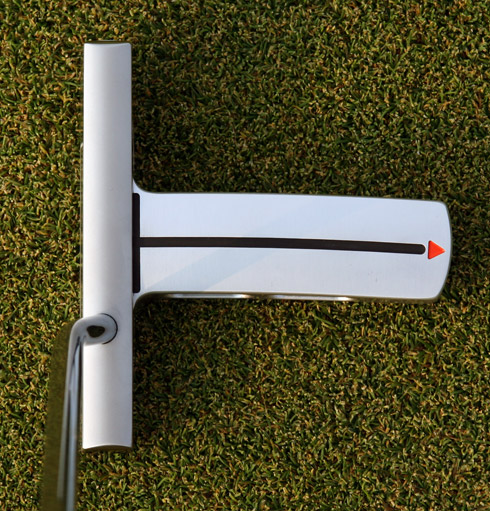
It’s not an optical illusion, I promise you – the back part of the putter really is curved.
If you’re a die-hard Pelz guy – a straight-back/straight-through type putter – then I can tell you now that the Detour is not for you. It does nothing to help you and will very likely mess you up. After all, the sight curve is curved!
But if you’re a Cameron guy, with an arced path, or you’re simply frustrated as heck with the “straight-back/straight-through” method, the Detour is built from the ground up to suit your stroke and visibly enforce the proper path.
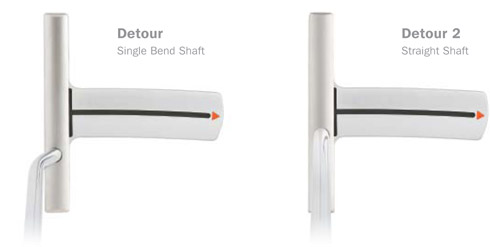
Design, Looks, and Setup
Half of the Detour very closely resembles a clean blade putter. What appears to be a face insert (but which is actually part of the main 6061-T6 aircraft aluminum body popping through the 303 stainless steel weighting component) occupies the center area of the face, while a bright orange “Scotty Cameron” is stamped in the heel. The shaft enters at the heel (and a little closer to center on the straight-shaft Detour 2), curving gently ahead of the ball before entering to “pre-forward-press” the putter. Hidden in the toe, a stainless steel weight enhances the toe hang and increases the MOI.
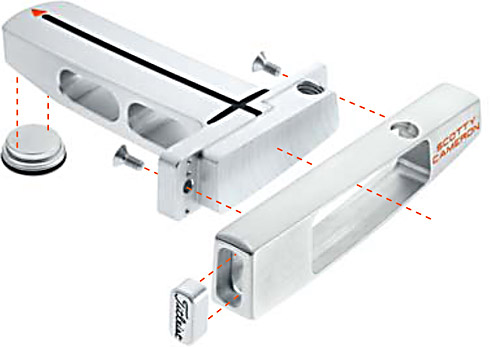
The putter face is actually part of the sight curve. With a stainless steel weight in the toe and one in the heel, the Detour has a high MOI in a fairly simple package.
Behind the face, things get a bit funky. For lack of a better name, I’ll refer to the part that sticks out as the “sight curve,” a sweeping piece of metal four or five inches long, curved gently inward towards the heel. A black line serves as a demarcation point between the face and the sight curve, which itself has a thick black line travelling down the center, capped with an orange triangle at the back edge.
The bottoms and sides prove a little more interesting. Portions of the sight curve’s insides are hollowed out from the sides, allowing Scotty Cameron to move weight further back. Stainless steel weights in the heel, toe, and tail end of the sight curve provide a triangle of weight which acts to increase the moment of inertia (MOI, or resistance to twisting) and help keep putts struck off-center on-line.
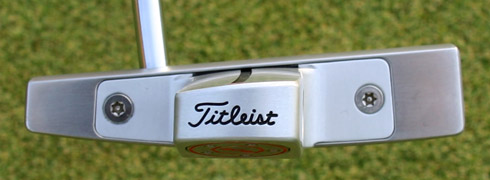
The Detour’s construction is simple. Here, Scotty’s “high toe” is plainly visible.
The putter itself, when viewed from behind, very clearly features Scotty’s trademarked “high toe,” a feature he includes in many putters to counter a player’s desire to tip the toe up at address, a habit which can lead to bad alignment and poor strokes.
All told, and though the putter may look a little unusual at address, it’s really no weirder than the Two-Ball, definitely not weirder than the Futura, and can slap around the Ping Doc with one stainless steel weight tied behind its back.
Performance
It’s been said that the Detour is a bit of a course-legal training aid that just so happens to be made by one of the finest putter craftsmen of our time, and I buy it.
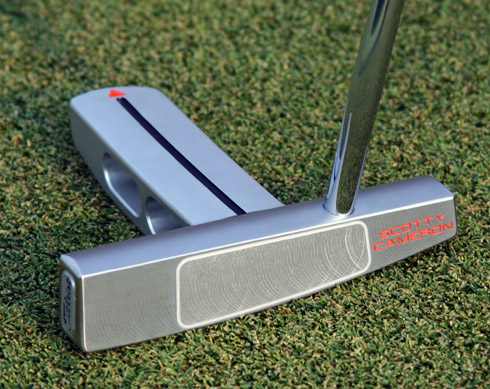
Give this putter a chance, and it’ll put the ball in the hole for you time and time again..
As I said, if you’re an arc putter (like everyone should be), then the Detour’s sight curve should do nothing but ingrain a perfect stroke. When you fail to take the putter back on the proper line, it’s obvious. If you have a tenth of Tiger Woods’ powers, you can stop your stroke and start over again. Or, when practice putting, simply ingrain, ingrain, ingrain.
Like any of Scotty’s putters – for which you admittedly pay a price premium – the Detour is a solidly built, solid performing putter. Contact on the sweet spot feels crisp. It’s a metal face, so you’re not going to get that mushy feeling you get off some Odyssey putters. Contact on the toe or heel result in minimal twisting (and thus minimal directional difference) but enough feedback to let you know you’ve missed the mark one way or the other.
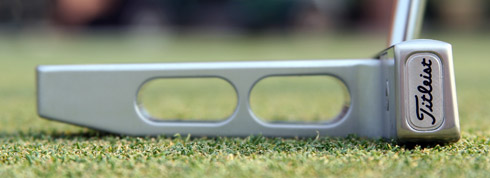
The sight curve is hollowed out left and right to make the stainless steel weights (one seen in the toe here) all the more effective.
Sound at impact is pleasing. I’ve stroked putters that make a “tink” sound and I’ve stroked putters that make a dull “thud” sound. The Detour’s sound, like its feel, is crisp and lively – and usually followed by the sound of urethane hitting whatever material comprises the bottom of the cup at your favorite course.
Though I’ve been a fan of mallet putters ever since I put a Ray Cook M1-X in my bag a dozen or so years ago, the Detour successfully blends the looks of a mallet, a blade, and a training aid.

Even the shaft band has a curved arc! Scotty is serious about improving your putting by putting properly. That doesn’t mean square to square!
Specs
The Detour is available with four degrees of loft and a lie angle of 71° (+/- 2° custom order) – pretty standard for Scotty Cameron putters. It’s available in 34″ and 35″ lengths for righties. Short lefties will have to grip down a bit on the 35″ version, as it’s all that’s available. I wish a 33″ version was available (it is via custom order), but lately Cameron has just been shipping 34″ and 35″ putters stock.
The Detour’s curved body is milled from 6061-T6 aircraft aluminum and includes a stainless steel backweight. The body (which is also the face) is then surrounded by a heel-and-toe balance component milled from 303 stainless steel.
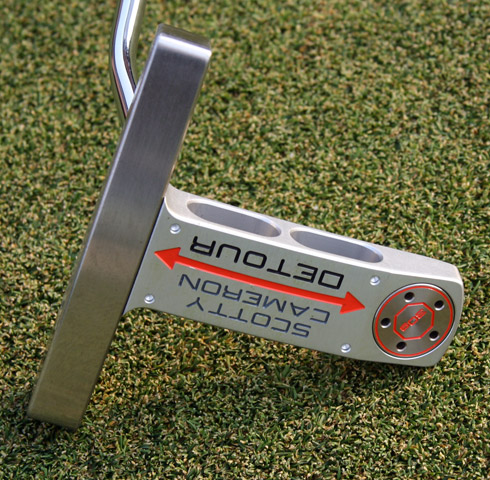
The stainless steel backweight can readily be seen here. The back weight feels as though it really helps to resist twisting and to impart a good topspin to the ball at impact.
The grip? A black Baby T. You can get a Red Baby T or a Red or Black Studio Design grip if you would like. The headcover is a bright orange affair with a Detour marking showing a putting arc. Two arms reach around the shaft and lock the headcover to the putter.
Conclusion
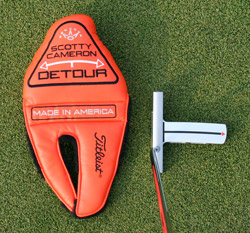 The Detour lives up to its name, swerving from the bulk of Scotty Cameron’s work to set out in a new direction. Unlike most detours, the route is – for many – actually a “better” way to get from point A to B. The Detour combines a “built-in training aid” in the sight curve with a solid feel and simple esthetics that do all they can to please the more traditional golfers in light of the sight curve.
The Detour lives up to its name, swerving from the bulk of Scotty Cameron’s work to set out in a new direction. Unlike most detours, the route is – for many – actually a “better” way to get from point A to B. The Detour combines a “built-in training aid” in the sight curve with a solid feel and simple esthetics that do all they can to please the more traditional golfers in light of the sight curve.
At $299, you’ll find the Detour is priced at roughly the same as every other Scotty Cameron putter. Golfers must answer the age-old question of “is it worth it” for themselves, but given that about 40% of your strokes come on the putting green, I know where my priorities lie. With Scotty Cameron putters, you know you’re purchasing a quality putting instrument.
I strongly disagree that the futura is “geeky”. it just has character!
I’ve putted with the Detour for two years now and it has definitely helped my handicap go from a 15, to a 12, to a 9. In other words I’ve made many more puts and my average puts per round are 30 and under. I love this putter so much that I bought another one shortly before Cameron stop making them. Currently, I use a Newport Studio Select, and love it, however, I know I always have my Detour to fall back on.
I just got this Detour on my bag. At the first sight, it looked so weird to me to have a curved line on the back of it. After reading this review to see how it works and I adjust myself to get familiar with it. It’s working out very well and I just love it.
Do you have any idea what the 35″ detour putters weight is on the backweight. I’ve looked everywhere and just cant find it…
thanks
Cameron Sandel
i have a 35″ detour and it has a 20g weight in it. I want to sell it if you want it!
Scott Cameron Detour vs Scott Cameron Newport? I have to go with the Detour. I think the design of the detour prevents the flat hits on the ball that don’t connect in contract right and creates misses. Once the looks and the feel of the Detour make you feel confident your putting game should really improve. It’s not the club, but the practice that comes with it. The science and thought behind the detour works, but again the player needs to practice and work the club. Regards, Jeff Stephan
Just won a putting contest out of 70 people. I have been training with a becu ping pal 4 then I bring in the detour and finish off my routine. So. Practicing with the blade and then isi. The detour on game day is really helping out swing and balance control with consistency. -Jeff stephan
I thought the one I bought was bent until I read this. It does make more putts!
One day a long time ago I spent a couple of hours on my local golf shop’s putting green trying out different putters. I went back a couple of days later and spent another hour trying out the ones I liked the best. The detour really stood out to me. It had the best feel, was most consistent and dropped the most balls in the cup. I bought it and have not regretted it one bit. Still using it to this day.
How do I get heavier weights for a Detour putter
Got one at a yard sale this past Saturday for $10. It’s about all I would pay for a Scotty. 27 holes so far and it’s OK but I haven’t tried the arc method. In 55 years I’ve always been straight back, straight through. I find a tendency to pull putts doing that with the Detour. So I’ll try the arc and see what happens. I can always go back to my 2-Ball or a Bobby Grace my course GM gave me. I’ve had BG putters before and Scotty can’t touch him.
I have a Scotty Cameron Detour putter that has never been used. It is for sale.